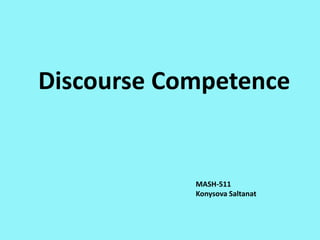
Discourse competence
- 2. The discourse competence had to await until the communicative competence was broken into sub- competences to appear as a goal in FLT. Canale and Swain (1980) and Canale (1983), distinguished four aspects of communicative competence:
- 4. ‘linguistic encoding’ ‘sociocultural orientation’ ‘discourse level of operation’. ‘sociosemantic basis of linguistic knowledge’ Munby (1978) defends a model with four distinct elements:
- 5. Discourse Competence can be seen as the ability to understand, create and develop forms of the language that are longer than sentences (stories, conversations, letters, …) with the appropriate cohesion, coherence and rhetorical organization to combine ideas. It consists of four main elements: purposes (aims, goals or objectives) instruction (treatment or procedures) content and evaluation
- 6. The discourse competence is defined as “the ability of a user/learner to arrange sentences in sequence so as to produce coherent stretches of language. It includes knowledge of and ability to control the ordering of sentences in terms of: • topic/focus; • given/new; • ‘natural’ sequencing: e.g. temporal: He fell over and I hit him, as against I hit him and he fell over. • cause/effect (invertible) – prices are rising – people want higher wages. • ability to structure and manage discourse in terms of: o thematic organisation; o coherence and cohesion; o logical ordering; o style and register; o rhetorical effectiveness;
- 7. For a text to have texture it must include “ties” that bind it together. These “ties” are called cohesive ties and, given that cohesion is expressed partly through the grammar and partly through the vocabulary, there are different types of cohesive ties, such as: Cohesion reference substitution Ellipsis discourse markers lexical cohesion
- 8. Cohesion “refers to relations of meaning that exist within the text, and that define it as a text” (Halliday & Hasan 1976:4). There is cohesion when the interpretation of an element in the text is dependent on that of another, that is, “cohesion is a semantic relation between an element in the text and some other element that is crucial to the interpretation of it” .
- 9. Coherence Richards, Platt and Platt (1993:61) define coherence as the relationships which link the meanings of sentences in a discourse. For example: * John hid Bill’s keys. He was drunk. * John hid Bill’s keys. He likes spinach. In the first utterance, we presume that hiding someone’s keys can be an effect of being drunk, so both sentences make sense even though they do not have anything in common related to grammar or lexicon; we simply know that when someone drinks a lot, he or she behaves in strange ways. However, in the second utterance, there is no coherence: the fact that John likes spinach does not have any relationship with that of hiding Bill’s keys.
- 10. Pirez Martin points out some examples of exercises to develop the discourse competence: 1. Lexical cohesion devices in context (e.g. use of synonyms) 2. Grammatical cohesion devices in context (e.g. ellipsis, logical connectors, parallel structures ) 3. Identify the clauses which has the thesis statement. 4. Oral discourse patterns (e.g. the normal progression of meanings in a casual conversation) 5. Link a paragraph with the following one. 6. Written discourse patterns (e.g. the normal progression of meanings in a formal letter) 7. To be able to work out an introduction/development/conclusion of a piece of oral or written language.
- 11. INNOVATIONS ABOUT THE DISCOURSE COMPETENCE Culture and discourse: contrastive rhetoric Critical thinking Content- based language teaching
- 12. Jacobs and Farrell (2001:6) give their definition and explain the benefits of content-based instruction: ‘Curricular integration serves to overcome the phenomenon in which students study one subject in one period, close their textbook and go to another class, open another textbook and study another subject. When various subject areas are taught jointly, learners have more opportunities to see the links between subject areas. By appreciating these links, students develop a stronger grasp of a subject matter, a deeper purpose for learning and a grater ability to analyze situations in a holistic manner’.
- 13. Contrastive rhetoric represents the study of diversity in discourse. Facing two written texts from two different communities, Contrastive Rhetoric wonders what these texts are like, what similarities and differences they have. After the analysis, it interprets both the similarities and the differences looking for historical, social, educational or any other plausible explanation. Finally, it provides teachers with suggestions to deal with diversity at the discourse level. Contrastive rhetoric has been changing during these 40 years but the key original idea, from 1966 article, can be summarised as follows (Kaplan 1966:2): ‘Logic (in the popular, rather than the logician's sense of the word) which is the basis of rhetoric, is evolved out of culture; it is not universal. Rhetoric, then, is not universal either, but varies from culture to culture and even from time to time within a given culture’.
- 14. Assessment of the discourse competence COHERENCE AND COHESION C2 Can create coherent and cohesive text making full and appropriate use of a variety of organisational patterns and a wide range of cohesive devices. C1 Can produce clear, smoothly flowing, well-structured speech, showing controlled use of organisational patterns, connectors and cohesive devices. B2 Can use a variety of linking words efficiently to mark clearly the relationships between ideas Can use a limited number of cohesive devices to link his/her utterances into clear, coherent discourse, though there may be some ‘jumpiness’ in a long contribution.
- 15. B1 Can link a series of shorter, discrete simple elements into a connected, linear sequence of points. A2 Can use the most frequently occurring connectors to link simple sentences in order to tell a story or describe something as a simple list of points Can link groups of words with simple connectors like ‘and’, ‘but’ and ‘because’. A1 A1 Can link words or groups of words with very basic linear connectors like ‘and’ or ‘then’.
- 16. Thanks for your attention!